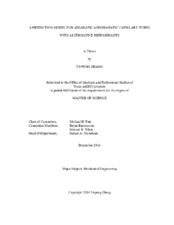| dc.description.abstract | The capillary tube is a very common throttling device located between the condenser and evaporator in a refrigeration system. In some refrigerant systems, a section of the capillary tube is connected to a section of the vapor return line (suction line) that exits the evaporator, which creates the so called capillary tube/suction line heat exchanger. Models to predict the mass flow in both adiabatic capillary tubes and capillary tube/suction line heat exchangers are developed in this thesis.
In order to predict the refrigerant mass flow in adiabatic capillary tubes and in capillary tube/suction line heat exchangers, a number of dimensionless correlations are developed. These dimensionless correlations are regressions of dimensionless parameters based on geometry factors, condition effects, and fluid properties, which are generated from the Buckingham Pi Theorem. The correlations for the mass flow of each individual refrigerant (R-134a, R-22, R410a) in the adiabatic capillary tubes were generated, as well as for each refrigerant (R-134a, R-22, R410a, R600) in the capillary tubes/suction line heat exchangers. The average deviations of the specific refrigerant correlations range from 1.27% to 6.30% for both the adiabatic capillary tube and heat exchanger. The deviation of the generalized correlation is 1.91% for adiabatic capillary tubes with subcooled inlet conditions, 4.89% for adiabatic capillary tube with quality inlet conditions, and 2.47% for heat exchangers with subcooled inlet condition. These newly developed correlations developed in this thesis can provide more accurate predictions for mass flow in both adiabatic capillary tubes and capillary tube/suction line heat exchangers when compared to the old correlations published in ASHRAE reports and Handbooks.
Generalized correlations with a reduced number of pi-terms were developed to predict the refrigerant mass flow. This simplification study shows that the accuracy is stable when the pi-term number is higher than 4 for adiabatic capillary tube simulations, and 5 for capillary tube/suction line heat exchangers. | en |


